Click on images to enlarge
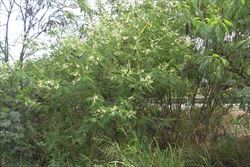
infestation (Photo: Chris Gardiner)
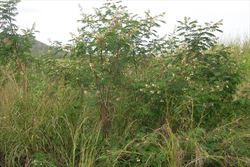
habit (Photo: Chris Gardiner)
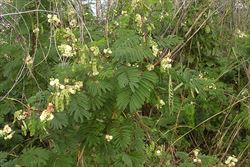
habit (Photo: Chris Gardiner)
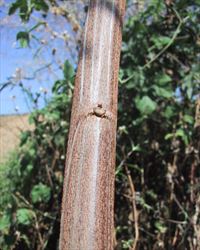
older stem (Photo: Chris Gardiner)
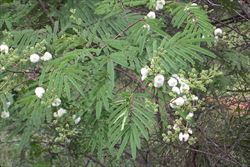
leaves and flower clusters (Photo: Chris Gardiner)
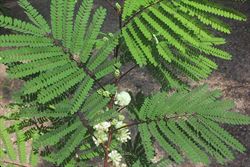
large twice-compound leaves (Photo: Chris Gardiner)

close-up of reddish stems and leaflets (Photo: Chris Gardiner)
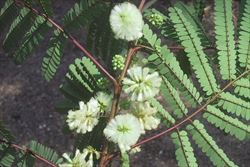
paler undersides of leaflets and globular flower clusters (Photo: Chris Gardiner)
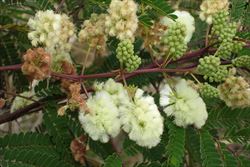
close-up of flower buds and slightly elongated flower clusters (Photo: Chris Gardiner)
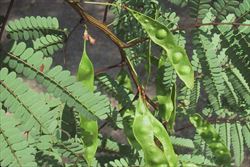
immature fruit (Photo: Chris Gardiner)
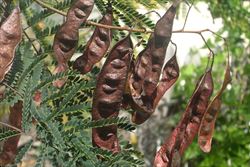
mature fruit (Photo: Chris Gardiner)
Scientific Name
Acaciella glauca (L.) L. Rico
Synonyms
Acacia angustissima (Mill.) Kuntze (misapplied)Acacia curassavica (Britton & Killip) StehleAcacia glauca (L.) MoenchAcaciella curassavica Britton & KillipMimosa glauca L.
Family
Fabaceae: sub-family Mimosoideae (New South Wales)Leguminosae (South Australia)Mimosaceae (Queensland, the ACT, Victoria, Tasmania, Western Australia and the Northern Territory)
Common Names
redwood, white ball acacia, wild dividivi
Origin
Native to the Caribbean (i.e. Barbados, Guadeloupe, Montserrat, Martinique, the Netherlands Antilles and St. Vincent) and north-eastern South America (i.e. northern Venezuela).
Cultivation
Three accessions of redwood (Acaciella glauca) were introduced into Australia for evaluation as a potential shrub forage legume between 1970 and 1972. They were wrongly introduced under the name Acacia angustissima. These accessions were mainly grown on agricultural field stations, but were not found to be particularly useful as fodder plants.
Naturalised Distribution
Occasionally naturalised in northern and central Queensland, particularly around Ingham. The distribution of this species in Australia is relatively unknown, although the Queensland Herbarium has 11 naturalised records from the area. One of these is from the Cook pastoral district, nine are from the North Kennedy pastoral district and one is from the South Kennedy pastoral district.
Redwood (Acaciella glauca) is also naturalised in south-eastern Asia (i.e. Thailand and Indonesia) and in the Cook Islands.
Habitat
This species has been found growing in a variety of habitats, from the coastal wet tropics to semi-arid inland environments, and on a variety of soil types. It is often found in open woodlands and grasslands, and along roadsides.
Habit
A large shrub or small tree usually growing 1.5-6 m tall.
Distinguishing Features
- a shrub or small tree with younger stems that are somewhat reddish in colour.
- its twice-compound leaves are fernlike in appearance and have several pairs of branchlets.
- its small white fluffy flowers are borne in globular or slightly elongated clusters.
- its fruit are flattened, elongated, pods (4-7cm long) that turn brown when mature.
Stems and Leaves
The stems are smooth in texture, sparsely hairy (i.e. puberulent) or almost hairless (i.e. glabrate), and do not have any spines. They are often reddish-brown in colour, particularly when young.
The twice-compound (i.e. bipinnate) leaves are finely divided and and fern-like in appearance. These leaves (4.5-13 cm long) are alternatively arranged along the stems and are borne on stalks (i.e. petioles) 2-5.5 cm long. Each leaf has 3-9 pairs of branchlets (i.e. pinnae) 3-6 cm long, and each of these leaf branches has 10-30 pairs of small leaflets (i.e. pinnules). These leaflets are generally somewhat oblong in shape (3.5-8 mm long and 1.8-2.4 mm wide) with rounded tips (i.e. obtuse apices). They are almost hairless (i.e. sub-glabrous) or slightly hairy (i.e. slightly pubescent) and have paler undersides (i.e. they are discolorous).
Flowers and Fruit
The white or cream-coloured flowers are borne in small dense clusters, with 3-5 of these clusters arranged in each of the upper leaf forks (i.e. axils). The clusters are rounded or slightly elongated in shape (i.e. globular or ellipsoid) and are borne on stalks (i.e. peduncles) 12-20 mm long. Each cluster contains numerous (15-30) small flowers that are borne on a very short stalk (i.e. pedicel) 0.6-1 mm long. The small flowers have five inconspicuous sepals (0.6-0.8 mm long), five tiny petals (2.5-3 mm long) and numerous (100 or more) prominent stamens (5-5.5 mm long) that give the flowers a very fluffy appearance.
The fruit is a relatively large, oblong, and flattened pod (4-7 cm long and 10-15 mm wide). They are hairless (i.e. glabrous) and turn from green to dark brown as they mature. Each pod contains 5-8 dark brown seeds, which are are oval (i.e. ellipsoid) or somewhat rounded (i.e. globular) in shape (3-5 mm long and about 3 mm wide).
Reproduction and Dispersal
This species reproduces by seed. The seeds may be eaten by cattle, other large animals, or birds and then spread after passing through their digestive systems intact. They may possibly also be spread by water or on vehicles.
Environmental Impact
Redwood (Acaciella glauca) is regarded as an environmental weed in northern Queensland and as a potential environmental weed in other parts of
This species has since been found in a variety of habitats in northern
Redwood (Acaciella glauca) was recently listed as a priority environmental weed in the Far North Queensland Natural Resource Management region. It is also regarded as being invasive on Mauke, in the
Legislation
This species is declared under legislation in the following states and territories:
- Queensland: Class 1 - introduction into the state is prohibited, and landowners must take reasonable steps to keep land free of this species (throughout the entire state). It is also illegal to sell a declared plant or its seed in this state. Note: This legislation applies to all Acaciella species.
- Western Australia: P1 - trade, sale or movement into the state prevented, and P2 - to be eradicated where found (throughout the entire state). Note: all non-indigenous species of Acacia are declared in this state, except mimosa bush (Vachellia farnesiana, syn. Acacia farnesiana).
Management
Similar Species
Redwood (Acaciella glauca) is similar to Bolivian wattle (Acaciella angustissima var. angustissima) and leucaena (Leucaena leucocephala), which were both also introduced into Australia as shrub legumes. These species can be distinguished by the following differences:
- redwood (Acaciella glauca) has smooth, almost hairless, younger stems that are reddish in colour. Its leaflets are moderately large (3.5-8 mm long and 1.8-2.4 mm wide) with rounded tips (i.e. obtuse apices). Its pods are relatively small (4-7 cm long and 10-15 mm wide) and each contains 5-8 seeds.
- Bolivian wattle (Acaciella angustissima var. angustissima) has slightly grooved (i.e. striated), finely hairy or hairless, younger stems that are greenish in colour. Its leaflets are relatively small (3-4 mm long and 0.5-1 mm wide) with slightly pointed tips (i.e. acute apices). Its pods are relatively small (4-8 cm long and 8-14 mm wide) and each contains about 5-8 seeds.
- leucaena (Leucaena leucocephala) has smooth, finely hairy, younger stems that are usually greenish in colour. Its leaflets are relatively large (7-21 mm long and 1.5-5 mm wide) with pointed tips (i.e. acute apices). Its pods are relatively large (8-22.5 cm long and 10-20 mm wide) and each contains 10-25 seeds.
There are also some white-flowered native wattles (Acacia spp.) that may occasionally be confused with this species. For a more in-depth key to all of the wattles (Acacia spp.) present in Australia, see the Wattle: Acacias of Australia CD-ROM or Flora of Australia, Volumes 11A and 11B.

